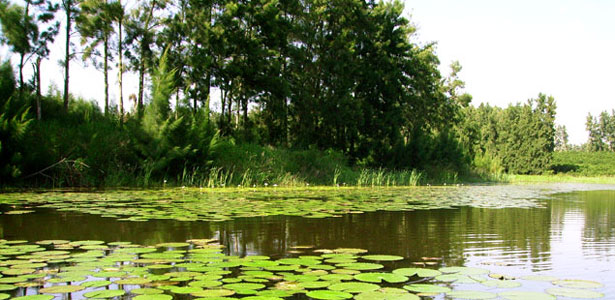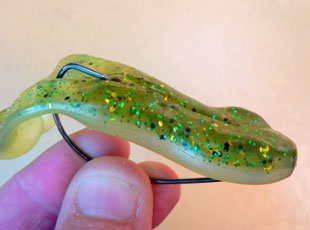Tackle Techniques
Top Frog
- Details
- Written by Andrew Court

Frog fishing is certainly not something new to the world of Bass fishing and anglers have been throwing these baits for decades in all shapes and sizes. In the past however these topwaters or ‘scum frogs’, as they were more commonly known, were generally all floaters, made of a hollow, soft rubber-type material, had a rubber skirt for a tail and armed with two large single hooks that lay over the back. They resembled anything from a frog to a mouse and were mainly fished over thick surface or matted vegetation. Over the years these baits seemed to fade off the scene and bait manufacturers stopped focusing on top water frogs until fairly recently when American pro Jay Yelas brought back into fashion the more refined Bronzeye Frog with its more realistic look and double strand tail. These floating type frog imitations proved to be excellent fish catchers over time but it was the introduction of Zooms soft plastic Horny Toad that got the attention of anglers and exploded a comeback in topwater frogging. Bait manufacturers soon latched onto the success of the Horny Toad and various shapes and designs hit the market including Stanleys Ribbit, Berkleys Bat Wing, Manns Hardnose Swimmin’ Toad, Yums Buzzfrog among others.
One of the unique elements that makes a good soft plastic top water frog is the shape of the body which is designed in a way that resembles a boat hull, keeping the bait running smoothly on the surface. This was one of the elements that Zoom incorporated into the Horny Toad design but the fish catching potential of the frog lies in not only how, where and when you fish it but also in the leg designs. Any soft plastic frog will catch fish but often some will work better than others depending on how much noise they make. There are basically 3 types of action legs and each frog has its own unique fish catching potential. The noisiest frog I have thrown is the Stanley Ribbit and Yum Buzzfrog which have large paddle feet and in terms of being a subtle buzzbait, create the most noise and commotion. In my experience Manns Hardnose with its ribbon tail legs, emits the least amount of noise and also has a sleeker more snake-like action. The Horny Toad with its speed or cut tail design, falls somewhere in between making it a good all rounder. Your choice of frog is something you need to experiment with on any given day and condition to determine the mood of the Bass – we all have our favourites.
One of the basic keys to fishing the plastic frog, which are not all designed to float when at rest, is retrieving it as slow as possible, at a constant speed, yet keeping it on the surface. This can be achieved by beginning the retrieve instantly when the bait hits the water and holding the rod tip fairly high when reeling, especially when making long casts. You can slowly lower the rod tip as the bait nears but keep a constant rythm to allow the Bass to home in. A longer, stronger rod and high speed reel will allow you to control this more easily, however in some situations like in short range, heavy cover fishing, a slower speed reel with more cranking power is often a better choice. In some situations a variation in the retrieve can be productive like in the case of lily pads for example, where you can bring your frog to rest on edges of holes or cuts and then after a few seconds pop the frog off for some explosive strikes. Allowing the frog to slowly sink into holes and openings in the cover can also bring results and adding a small shot or bullet to the nose of the frog will give it the necessary weight to keep the baits leg action as it falls.
 One of the hardest things to do when fishing the plastic frog is waiting to feel the weight of the fish before setting the hook. Your immediate reaction when seeing the boil or explosion is to strike but this can often result in pulling the bait away from the fish. When you see the hit try and give it a couple of seconds as you take up some slack – set the hook! However we have to acknowledge the abilities of a Bass as a hunter and if you are getting a lot of hits but no fish, slow down even more if possible, make a colour change or just convince yourself that there is a good chance these are the smaller fish. In my experience if a Bass wants to eat that frog and he’s of good keeper size or more – he doesn’t miss! Nevertheless it’s always a good idea to throw straight back to the area or keep a ‘stinger’ rod handy rigged with another bait that you can immediately deliver to the crime scene. Bass often hang around a little after attacking the frog with the hope of maybe picking off what he just stunned or killed and will often nail the other slow sinking bait.
One of the hardest things to do when fishing the plastic frog is waiting to feel the weight of the fish before setting the hook. Your immediate reaction when seeing the boil or explosion is to strike but this can often result in pulling the bait away from the fish. When you see the hit try and give it a couple of seconds as you take up some slack – set the hook! However we have to acknowledge the abilities of a Bass as a hunter and if you are getting a lot of hits but no fish, slow down even more if possible, make a colour change or just convince yourself that there is a good chance these are the smaller fish. In my experience if a Bass wants to eat that frog and he’s of good keeper size or more – he doesn’t miss! Nevertheless it’s always a good idea to throw straight back to the area or keep a ‘stinger’ rod handy rigged with another bait that you can immediately deliver to the crime scene. Bass often hang around a little after attacking the frog with the hope of maybe picking off what he just stunned or killed and will often nail the other slow sinking bait.
To give yourself the best chance of a good hook up, rigging the frog correctly is important. Frogs are fairly bulky baits and require a larger hook to give you a bigger bite gap on the strike. Nothing smaller than a 4/0 wide gap should be used, depending on the size of your frog and on the bigger ones I’ve seen even 7 and 8/0’s rigged up. With most frog sizes however, a 5/0-6/0 wide gap will do the trick. The frog is rigged as straight as possible, weedless and weightless, texas style with the point lightly skin hooked on the frogs back. Some frog designs provide grooves on the dorsal area of the bait to allow for exposed but protected hook points. The shank of the hook lies below the frogs belly and creates a keel-type effect, much like that of a yachts skeg and helps the bait to remain up right. Being quite heavy for a soft plastic bait and fishing it regularly over and through cover, the head of the frog sometimes has the tendancy to slide off the eye. Adding a bead or a weightless screw lock bullet to the line ahead of the frog can help eliminate this or there are brands of frog hooks available which incorporate a screw locking device attached to the hook eye. However if at all possible rig it standard so the frog can slide up the line during the fight. As mentioned it’s usually necessary to use larger hooks and often you will find that the hook length exceeds the bait length. In this case instead of going to a smaller hook, simply place the point up between the frogs legs and skin hook it in the back. This will still keep the frog rigged straight and will ensure you of a good hook up.
Depending on the conditions frogs can be fished practically anywhere, in any season, over any depth and around any cover but are generally more effective as shallow, warmer water weed warriors down to about 10 - 12 ft. Frog species usually prefer shallow, weedy areas especially floating or surface type weed and grass close to and around the bank. Although I feel that frog species have declined over the years, I believe the Bass instinctively knows where he can ambush them and these weed areas is where fishing this bait can be highly effective. In fact any place where you would feel the urge to throw a surface lure or Buzzbait – is good place to throw your frog. The difference being is that, when rigged correctly, the frog is far more weedless than a lot of other surface baits, is more of a finesse presentation than a Buzzbait, has a more natural look than other reaction lures and at the end of the day is a soft plastic so can be fished sub surface if needed. Other than vegetation as a prime spot for frog fishing, jetties, rip-rap banks, timber and fence rows can all be productive areas.
When it comes to gear it’s wise to use the big guns in your arsenal – as mentioned medium heavy and heavy 6.5 - 7 ft rods with strong line is a must for heavy cover like lily pads, brush or thick surface vegetation. Non or low stretch braid or fluorocarbon lines will help stitch and get the Bass out in these situations however, slightly lighter gear will be okay for more open water or sparse cover but don’t skimp too much – lighter stretchy line and bendy rods will cost you fish at the end of the day. Frog colours are numerous so stick to the basics with dark colours for low light or stained water and more natural colours for clear or brighter conditions. However experiment with a few colours and laminates until you find out what’s working – my favourite colours are black, watermelon red, watermelon gold/white belly, black/chartreuse belly and white. In high visibility water the translucent colours or clear can be productive.
These baits under a lot of situations are awesome and a ton of fun to fish - but be ready as the hits are usually fierce! In fact its quite exciting watching how Bass attack the frog with some porpoising onto it while others smash it hard from underneath, or even gently just inhale it leaving nothing but a small swirl on the surface. Frogs can be a prized food source for Bass, a total irritation that needs immediate eradication or even better – simply dessert! There are times that they hit these things so regularly I can’t help feeling that the plastic frog, even to the Bass - is just pure entertainment!


 Visit us our
Visit us our